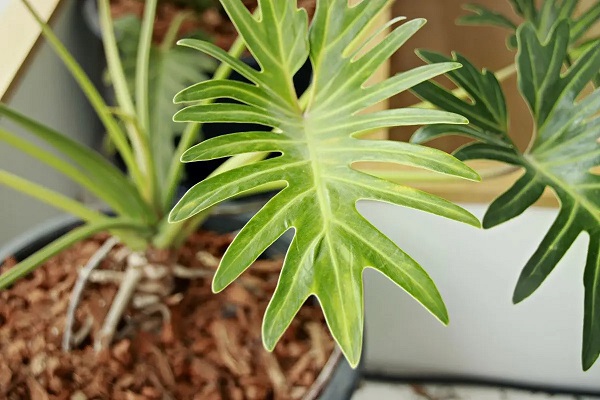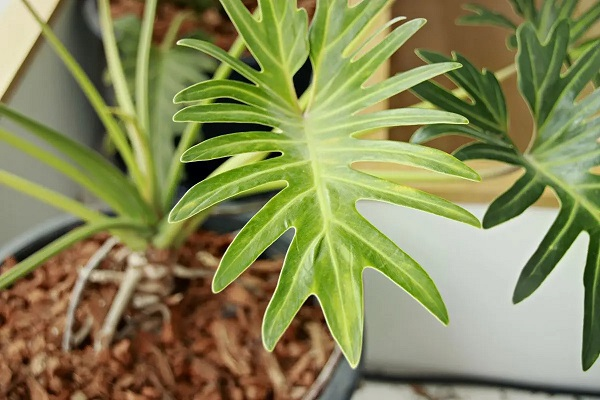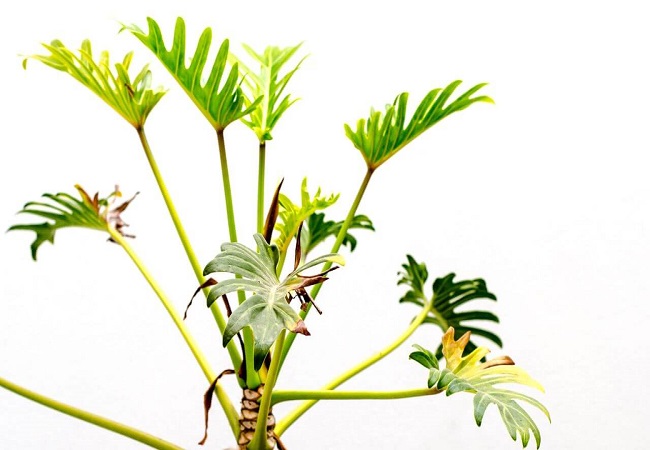Understanding the underlying causes of yellow leaves in Philodendron Xanadu, a popular houseplant known for its lush foliage and vibrant green color, is essential for maintaining its health and vitality. Yellowing leaves can be a distressing sight for plant enthusiasts, indicating that something is amiss within the plant’s environment or care routine.
In this article, we will explore the various factors that contribute what causes Philodendron Xanadu yellow leaves, shedding light on both environmental and cultural factors, nutrient deficiencies, pests, and diseases that may be responsible for this condition. By gaining insight into these causes, you will be equipped with the knowledge to identify and address the issues, ensuring your Philodendron Xanadu thrives and regains its vibrant green foliage.
Quick Navigation
Why Are Philodendron Xanadu Yellow Leaves?

Philodendron leaves can turn yellow can be alarming when a Philodendron’s leaves start to turn yellow and fall off. Yellowing may result from several factors, but the most common one is nitrogen deficiency. Philodendrons need nitrogen to create their green leaves and flowers. If you are not providing enough of this essential nutrient, your Philodendron will turn yellow and fall leaves. There are also other causes of leaf yellowing, such as fungal or bacterial infection, so diagnosing and treating the problem is important.
The Most Common Causes Of Philodendron Xanadu Yellow Leaves

Several different factors can often cause Philodendron Xanadu’s yellow leaves. Some of the most common are:
Nitrogen deficiency
This is the most common cause of leaf yellowing in Philodendrons. If you are not providing enough nitrogen to your Philodendron, it will turn yellow and fall leaves.
Over-watering
Water your Philodendron regularly, but do not water it so much that the soil becomes soggy. Over-watering can cause root rot, which will then cause the leaves to turn yellow.
Under-watering
Philodendrons need water but do not allow the soil to become soggy. Under-watering can also lead to root rot and leaves turning yellow.
Lack of sunlight
If your Philodendron is not receiving enough sunlight, it will turn yellow and fall leaves.
Poor circulation
Poor circulation can be caused by a build-up of soil on the roots or around the plant’s stem. This can make it difficult for the plant to get enough oxygen and nutrients, which will then cause leaves to turn yellow and fall off the plant.
Fungal or bacterial infection
If you notice your Philodendron has yellow leaves, it is important to look for any fungal or bacterial infection signs. If you find any evidence of infection, treatment with anti-fungal or anti-bacterial medication may help cure the problem.
Chlorosis
Chlorosis is a chlorophyll deficiency in plants caused by several factors, one of which is low light levels. Chlorosis results in pale green or yellow leaves that may eventually fall off the plant.
Pests
Several pests can cause leaves to turn yellow and fall off Philodendrons. These include aphids, scale insects, mealybugs, and white flies. A plant doctor should be consulted if you notice any of the following symptoms.
Nutritional deficiencies
One common cause of leaf yellowing in Philodendrons is a lack of certain nutrients. If you are not providing your Philodendron with the correct nutrients, it may struggle to produce healthy leaves. Check your plant’s soil and water needs to make sure you are meeting its needs.
Metabolic problems
If your Philodendron is growing slowly or not producing leaves, it may be due to a problem with its metabolism. Check for poor root growth, delayed blooming, or weak stems. Consult a plant doctor if you see any of these symptoms.
How to Fix Philodendron Xanadu Yellow Leaves?
If your Philodendron is exhibiting yellow leaves, the plant is likely stressed. You can help your Philodendron get back on track by implementing the following suggestions:
- Check the temperature and humidity levels in your home. If the temperature is too high or the humidity is too low, this can lead to plant stress. Make sure that both levels are at an appropriate level for your Philodendron’s specific environment.
- Remove any excess water from the plant’s potting soil every day. This will help to reduce waterlogging and provide better air circulation for the plant.
- Give your Philodendron a good fertilization program in early spring and during the summer months. Your Philodendron will benefit from a well-balanced fertilizer, which will help it grow and improve its foliage.
If all else fails, consult a plant doctor. There may be a problem with the plant’s metabolism that needs to be corrected with medication or other treatments.
FAQ about Philodendron Xanadu yellow leaves
Should I remove yellow leaves from Philodendron?
The leaves on your Philodendron should be mostly green. You can remove any yellow leaves, but only if they really affect the plant’s overall appearance. If there are just a few yellow leaves, it’s best to leave them alone.
Will yellow leaves turn green again?
The leaves of a Philodendron plant will typically turn from green to yellow as they age. While some leaves may stay yellow, most will eventually turn green again. This process is due to the plant’s natural growth and aging cycle.
How do you save a dying Xanadu?
To save a dying Xanadu Philodendron, you must first assess the plant’s condition. If the plant is wilting or has yellow leaves, it is likely not getting enough water. You can try misting the leaves or soaking the pot in water to increase the water uptake. If the plant is losing its color, it may not be getting enough light.
Can Xanadu plants be in full sun?
The plants in question, Xanadu plants, likely prefer full sun exposure. However, as with all plants, it is important to consider the specific needs of the individual species. Some may require more sunlight than others, and some may be able to tolerate a bit more shade than others. It is best to consult with a local nursery or garden expert to determine whether or not your specific Xanadu plants will thrive in full sun.
How often should I water Xanadu?
Watering Xanadu is a process that should be done often to ensure the plant’s health. The watering frequency will depend on various factors, such as the climate, the type of soil, and the size and age of the plant. Newly planted plants should be watered daily, while older plants can go a few days between waterings.
Why is my Xanadu dying?
Your Xanadu is dying because it is not receiving adequate care. The most likely cause is that you are not providing it with the right type of water, light, or soil. Without the correct level of care, your plant will slowly deteriorate and eventually die.
Conclusion
Identifying and addressing the causes of yellow leaves in Philodendron Xanadu is essential for maintaining the plant’s health and beauty. Throughout this article, we have explored various factors that can contribute to this condition. Environmental factors such as excessive sunlight, improper watering, or extreme temperatures can lead to leaf discoloration. Inadequate care practices like overwatering or poor drainage can also result in yellowing leaves. Nutrient deficiencies, particularly iron or nitrogen, may manifest as yellowing foliage as well. Additionally, pests such as spider mites or diseases like bacterial or fungal infections can affect leaf coloration.

Plants are my life. I’m a plant whisperer and an amateur gardener who loves to share gardening tips and tricks with you!


